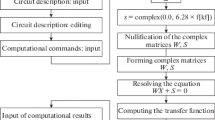Abstract
This paper presents a system model for the representation of amplifiers that cannot be accurately characterized by a classical two pole transfer function. The effects of higher order poles are modeled by an all-pass function added to the conventional two pole model. The accuracy of the model is demonstrated by comparing the results for a typical CMOS amplifier to those obtained from device level simulations using SPICE. This model can be easily implemented in a standard simulator and is shown to achieve fast simulation time. This model is expected to have application in system level modelling of mixed-signal circuits using conventional SPICE simulators.
Similar content being viewed by others
References
A.S. Sedra and K.C. Smith, Microelectronic Circuits, 4th edition, Oxford University Press, New York, 1997.
D.A. Johns and K. Martin, Analog Integrated Circuit Design, John Wiley & Sons, Inc., New York, 1996.
Schaumann, Ghausi and Laker, Design of Analog Filters. Prentice Hall, New Jersey, 1990.
A. Vladimirescu, The Spice Book. John Wiley & Sons, Inc., New York, 1994.
D.T. Comer, Introduction to Mixed Signal VLSI. Array Publishing Co., New York, 1994.
C.L. Phillips and R.D. Harbor, Feedback Control Systems, 3rd edition, Prentice Hall, New Jersey, 1996.
P.E. Allen and D.R. Holberg, CMOS Analog Circuit Design, 2nd edition, Oxford University Press, New York, 2002.
G. Palmisano and G. Palumbo, “A novel representation for two-pole feedback amplifier.” IEEE Trans. Education, vol. 41, no. 3, pp. 216–218, 1998.
Author information
Authors and Affiliations
Corresponding author
Additional information
Yihong Dai received his B.S. and M.Eng. degrees in Electrical Engineering from Shanghai JiaoTong University, Shanghai, China in 1993 and 1996, respectively. From 1996 to 1998, he enjoyed his industrial experiences in Shanghai with semiconductor companies like Shanghai Nortel Semiconductor and Motorola Electronics (China) Shanghai Branch. Since 1998, he has been a research assistant at the Analog and Mixed-signal Laboratory of the Electrical Engineering Department of Brigham Young University working toward his Ph.D. During the summer of 1999, he was with AMI semiconductor Utah Research and Design Center where he developed a threshold voltage based CMOS voltage reference architecture. In the summer of 2001, he was with Ultra Design where he designed a reference amplifier for high speed digital-to-analog converters. His research interest includes voltage reference, reference amplifier and high speed data converters in both CMOS and GaAs processes.
Donald T. Comer received the B.S, M.S., and Ph.D. degrees from San Jose State University, the University of California (Berkeley), and the University of Santa Clara, respectively, all in electrical engineering. He began teaching at San Jose State University in 1961 and mixed his teaching and industrial work until he left San Jose State University in 1979. He has worked for California Technical Industries, IBM Corp., Mobility Systems, Precision Monolithics, Storage Technology Corp., and Analog Devices during his career. He founded the AMI Utah Research and Design Center in 1998 that specializes in MOS design. In 2002, Dr. Comer founded Ultra Design, a design center that specializes in high-frequency heterojunction circuit designs. He holds fifteen patents and has published over 50 articles dealing with solid-state and integrated circuits. He has published five textbooks in the field of large-signal and integrated circuits. He formerly held the Quentin Berg Chair at Penn State Harrisburg from 1990 to 1995. He is now a professor of electrical and computer engineering at Brigham Young University where he held the Endowed Chair of Engineering from 1995 to 1998.
David J. Comer received the B.S., M.S., and Ph.D. degrees from San Jose State University, the University of California (Berkeley), and Washington State University, respectively, all in electrical engineering. He has worked for IBM Corp., Pacific Electromagnetics, Lawrence Livermore Laboratories, and Intel Corporation. He began his teaching career at the University of Idaho and has taught at the University of Calgary and California State University, Chico. He is presently a professor of electrical and computer engineering at Brigham Young University. He served as Chairman of the Division (Dean) of Engineering at CSU, Chico and as Department Chair at BYU.
While at CSU, Chico, Dr. Comer served on the statewide Engineering Liaison Committee and served as Chair of the Council of California State University Deans of Engineering.
Dr. Comer has published twelve textbooks and over 60 articles in the field of circuit design. He has contributed sections to the Encyclopedia of Physical Science and Technology and holds seven patents. He was given the Professional Achievement Award at CSU, Chico and was named the Outstanding Teacher of Engineering at BYU. He has also held the College of Engineering Research Chair at Brigham Young University.
Darren Korth received the B.S. and M.S. degrees in electrical engineering at Brigham Young University, Provo, Utah in 1999. He is currently pursuing a Ph.D. in electrical engineering. He served as an instructor for the Department of Electrical and Computer Engineering at Brigham Young University from 2000 to 2002. From 2001 to 2003, he also worked as a senior design engineer at UltraDesign, LLC, Provo, Utah where he researched high-speed data converter circuits. He is currently with AMI Semiconductor in their RF CMOS group.
Rights and permissions
About this article
Cite this article
Dai, Y., Comer, D.T., Comer, D.J. et al. Simplified Modeling of a Multipole Amplifier Using All-Pass Network Functions. Analog Integr Circ Sig Process 43, 39–47 (2005). https://doi.org/10.1007/s10470-005-6569-8
Received:
Revised:
Accepted:
Issue Date:
DOI: https://doi.org/10.1007/s10470-005-6569-8




